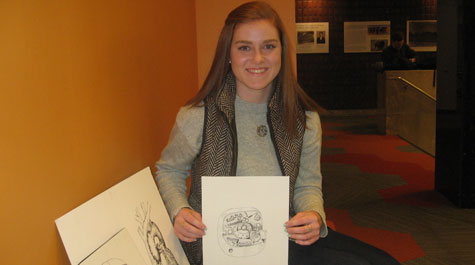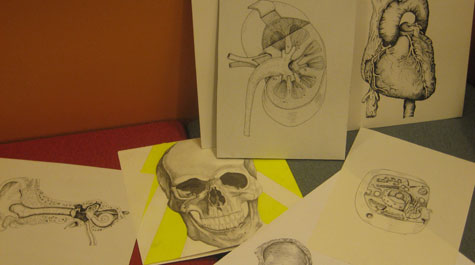Student finds medical illustration specialty a perfect blend
All set to major in pre-med in college, Molly Bryant ’18 hit pause.
It would be a crime for you not to do something with art, her Advancement Placement drawing teacher told her during her senior year of high school. That, combined with an alumnus coming back to talk about the field of medical illustration, propelled her toward what is turning out to be a perfect combination of medicine and art.
“I’ve been doing it for a while, and I really like it,” Bryant said.
Doing artwork since childhood, the Connecticut native had no plans to study it in college and wanted to become a doctor. But after her teacher’s comment, she enrolled at a college that specialized in medical illustration before transferring to William & Mary two years ago.
She came in as a kinesiology major with a fine art minor, but has now switched to make fine art her major while continuing to take prerequisite courses for medical school.
“I absolutely love it,” Bryant said. “I worked with the kinesiology department and did some illustrations for their anatomy lab manuals. I’ve done illustrations of experimental setups for professors who are publishing papers, and if they needed a muscle illustrated or something like that.”
A very old art form still done by some with pencil on paper, medical illustration is a specialized field where anatomical drawing must be done precisely before being uploaded to digital platforms or labeled for instructional use. There is a professional association for those who ply the trade, working in a variety of roles from making illustrations for hospitals to educate patients on surgeries to drawings for cases in a law setting.
Bryant said she learned through practicing, repeating and, yes, erasing and redoing her work. She is a horseback rider and emergency medical technician and draws a lot of animals because they are so closely related to humans.
“I’ve always been really interested in anatomy,” she said. “So I’ve bought a lot of anatomy books and coloring books and textbooks, and I would just study it over and over.”
Her anatomy class at W&M gave her access to the cadaver lab, which she said “allowed me to kind of really physically put my hands on things to really understand where things are.” She did illustrations in place of formal assessments there, saying having an actual cadaver to work from was a really good learning tool to have.
“I’ve just kind of been obsessed over it for so long that I have just really honed my skills in anatomical drawing,” Bryant said.
The drawings rely on contrast to show depth and complexity. She goes very slow in the beginning to make sure that the outline is just right.
“I generally do a contour line of just kind of the basic things, like block it out,” Bryant said. “And then I look for light and shadow. And then I go back in and I do the dark first usually, and kind of identify where things are going to be receding and coming out.”
The fact that there’s only one accurate way to draw the subject matter is helpful, she said, because there’s no attempt to create something that is perhaps complex and undefinable.
“I’m very detail-oriented,” Bryant said. “So doing something like this is perfect for me because it is very detailed.”
Bryant was inspired by Frank Netter, a surgeon and renowned medical illustrator who lived before digital tools were available to help. She said she personally likes that her illustrations look hand-drawn because they look more real.
Still planning to go on to medical school, Bryant said she really likes surgery and especially reconstructive plastics or cardiology. Creating illustrations for plastic surgery patients to be able to help them understand their upcoming procedures would make them feel more comfortable.
“Because I think very much in the surgical world it’s very sterile and there’s not a lot of patient to surgeon interaction,” Bryant said. “So I think with illustrations and art you can make that a better relationship. Because I just think art and surgery kind of go hand in hand.
“And being able to understand the human body on a two-dimensional form will just help you even more in 3-D and back and forth. So I think they both really play to each other well.”
Bryant said she thinks that studying medicine and art together is really unique and that using both sides of the brain helps to become a more well-rounded student and person.
“I find that’s a really nice combination,” she said.

















